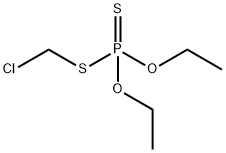CHLORMEPHOS

- CAS No.
- 24934-91-6
- Chemical Name:
- CHLORMEPHOS
- Synonyms
- DOTAN;MC2188;P 2188;ai3-25533;CHLORMEFOS;CHLORMEPHOS;caswellno195b;Chlormethylfos;chlormephos(bsi,iso);CHLORMEPHOS STANDARD
- CBNumber:
- CB4364182
- Molecular Formula:
- C5H12ClO2PS2
- Molecular Weight:
- 234.7
- MOL File:
- 24934-91-6.mol
- Modify Date:
- 2024/3/14 15:18:26
| Melting point | 25°C |
|---|---|
| Boiling point | bp1mm 93-95°; bp0.1 Torr 81-85° |
| Density | d20 1.260 |
| vapor pressure | 7.6 Pa (30 °C) |
| refractive index | nD220 1.5244 |
| Flash point | 100 °C |
| storage temp. | 0-6°C |
| Water Solubility | 60 mg l-1(20 °C) |
| form | liquid |
| EPA Substance Registry System | Chlormephos (24934-91-6) |
SAFETY
Risk and Safety Statements
| Symbol(GHS) |   GHS06,GHS09 |
|---|---|
| Signal word | Danger |
| Hazard statements | H300+H310-H410 |
| Precautionary statements | P273-P280-P301+P310+P330-P302+P352+P310-P391-P501 |
| Hazard Codes | T+,N |
| Risk Statements | 27/28-50/53 |
| Safety Statements | 28-36/37-45-60-61-27 |
| RIDADR | 3018 |
| RTECS | TD5170000 |
| HazardClass | 6.1(a) |
| PackingGroup | II |
| Toxicity | LD50 in rats (mg/kg): 7 orally; 27 dermally; LC50 in fish: 1.5 mg/l (Lynch) |
CHLORMEPHOS Chemical Properties,Uses,Production
Uses
Chlormephos is used to control soil insects such as wireworms in a number of crops.
General Description
Colorless liquid. Used as a soil insecticide. Not registered as a pesticide in the U.S.
Air & Water Reactions
Slightly soluble in water [Farm Chemicals Handbook].
Reactivity Profile
Organophosphates, such as CHLORMEPHOS, are susceptible to formation of highly toxic and flammable phosphine gas in the presence of strong reducing agents such as hydrides. Partial oxidation by oxidizing agents may result in the release of toxic phosphorus oxides.
Health Hazard
(Non-Specific -- Organophosphorus Pesticide, Liquid, n.o.s.) CHLORMEPHOS is poisonous; it may be fatal if inhaled, swallowed, or absorbed through the skin.
Fire Hazard
(Non-Specific -- Organophosphorus Pesticide, Liquid, n.o.s.) Container may explode in heat of fire. Fire and runoff from control water may produce irritating or poisonous gases.
Metabolic pathway
Chlormephos is a soil insecticide with considerable vapour phase activity. The main soil metabolite is ethion. The mechanism of hydrolysis of chlormephos is mainly by the nucleophilic attack of OH- on the Smethylene carbon to yield O,O-diethyl phosphorodithioate and in this respect it is similar to mecarbam. This mechanism may afford ethion when the nucleophile is O,O-diethyl phosphorodithioate. The other mechanism of hydrolysis is by attack on phosphorus to yield O,O-diethyl phosphorothioate and these two routes of hydrolytic degradation apparently dominate the metabolism of the insecticide.
Metabolism
In soils, chlormephos is converted to ethion by reaction with the hydrolytic product, O,O-diethyl hydrogen phosphorothioate.





